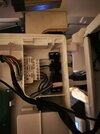I would say it will need new cables, but very short from hub to boiler. However as to if OpenTherm really helps depends on the set up and boiler.
My mothers house had a gas Worcester Bosch boiler, which does not support OpenTherm, all is done using the return water temperature, but there is a flaw, the boiler without a wall thermostat would never switch fully off, it would cycle on/off, the anti-cycle software would reduce how often the boiler fires up to try, but it needs some method to switch it off when whole house warm.
If the boiler is switched off, and then back on, it will switch on at maximum output with some boilers, although not all, so the less the boiler is switched on/off the better. Also the boiler is controlled by the by-pass valve in or near the boiler opening so hot water is returned fast, having a bathroom towel rail or the radiator where the thermostat is without a TRV can upset some boilers.
The installers used this
thermostat which to stop hysteresis starts switching off/on before it reaches target to stop it over shooting, and the thermostat was placed in the hall, with no TRV in the hall, so every time my mother went out the hall would cool down front doors tends to stay open a long time when in a wheel chair, and if the lock shield set so hall temperature would recover then hall heated up too quick when door not open, and made rest of house cool.
Adding a TRV to hall radiator transformed whole house, as then the hall could recover fast until at around 16ºC then slow up before reaching 19ºC at what the wall thermostat was set to. I am not saying this will work with every house, but it did with hers.
In fact it does not work with this house, hall cools too slowly, I can set heat up speed with the lock shield valve, but no way to control cool down speed.
Some times the simple thermostat works better, but if you want a Eco and Comfort setting, no good doing it with just the wall thermostat, it needs matching with the TRV. And if the radiator heats up too fast, the TRV will not have enough time to close, and so start a hysteresis.
I used these

in mothers house, they worked well, but the anti-hysteresis software was OTT, so set to 22ºC at 7 am and 20ºC at 8 am or it would have been 10 am before room at 20ºC.
This house I have also used these

which were far cheaper I paid £15 each in 2019, so have 4 of the Energenie and 5 of the eQ-3 the latter seem to work better than the more expensive wifi versions, non link to wall thermostat.
I think I may have been better with Drayton Wiser, the TRV algorithms are better, designed to work out how long it takes to heat the room, but I wanted CH and DHW control in main house hard wired, and Nest Gen 3 did this with the two existing wires, and I thought when I fitted it that it would work with Energenie, seems Nest withdrew support.
However the TRV is king, the wall thermostat is only there to stop the boiler cycling, once the lock shields are set to stop any hysteresis even the mechanical TRV's do work spot on.






